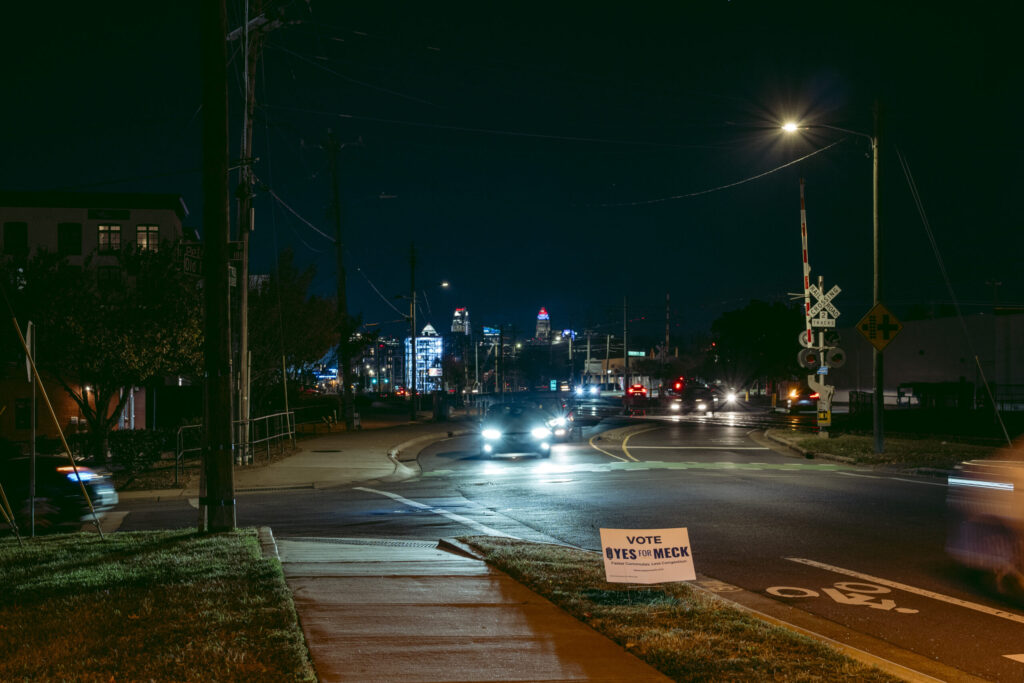Two years ago, when a small group of Charlotte business and civic minds huddled to plot a transportation investment in Mecklenburg County, they estimated the odds of getting it passed were 100 to 1.
They first had to write a bill that a majority of the county’s towns would support. Then they had to lobby the Republican-led legislature to let voters decide on a 1-cent sales tax increase. Then they had to convince voters.
Last night, in a private room at a party for the “Yes For Meck” campaign, some of those same people curled over a computer screen, fidgeting and waiting for updated election results. At 10:18 p.m. they started clapping, which caused people in the main room to clap, which soon led to a few yelps and hoorahs, which all signaled that the 100-to-1 shot had come in: Mecklenburg County’s voters approved a 1-cent sales tax referendum to pay for up to $25 billion in roads, rail, and bus improvements over the next 30 years.
“This was literally like threading a camel through the eye of a needle,” local attorney Larry Shaheen, a Charlotte native and political strategist who helped lead the campaign, told me last night, referencing the biblical metaphor, the one about rich men getting into heaven.
In sheer dollars, last night’s vote makes this one of the most ambitious investments in any city our size in the U.S. Austin passed a $7.1 billion plan funded by a sales tax in 2020; Nashville last year passed a $3.1 billion plan, funded by a sales tax increase.
“This is very profound. $20 billion. $25 billion with [matching federal] grants. In one county?” Ned Curran, the CEO Emeritus of Northwood office and the former state transportation board chair, said. “That’s a game-changer. That is a profound amount of money to do some really great things. It will touch virtually every mode of transportation. Walking, biking, scooter. It will touch everybody.”
The referendum requires 40 percent of the money to be spent on roads, 40 percent on rail, and 20 percent on buses. It passed by less than 8,000 votes out of about 177,000 cast, 52 percent to 48 percent. Northwest and southeast Mecklenburg precincts voted against it. Voters in Matthews rejected it with all they had, with some precincts showing nearly 70 percent opposition. That’s no surprise, given that the extension of an east-west Silver Line that was planned to run to Matthews now will stop well short at Bojangles Coliseum.
The bigger concern for opponents, though, is how the investment will affect historically disadvantaged people. Sales taxes are regressive, meaning that poor people spend a larger percentage of their income on it. And displacement is a real worry — running a light rail to the airport, for instance, will likely increase development in historically Black west Charlotte.
“This plan also places a funding burden most squarely on the shoulders of those who not only will get less transportation benefit from it than they deserve, but also places the burden of financing the plan squarely on the shoulders of those least able to afford a substantial increase in the sales taxes they will pay,” opposition group Action NC wrote in a social media post last night.
Opponents have long said it was a David vs. Goliath battle. They spent less than $10,000 to challenge the referendum, according to Axios, while supporters aimed to raise $3 million to convince people to vote for it.
But architects of the bill would argue that they were underdogs for more than two years, if you consider where they started.

In the winter of 2020, a task force led by former Mayor Harvey Gantt recommended raising the sales tax by a penny to fund up to $12 billion in transportation improvements. At the time, leaders believed Mayor Vi Lyles’ push to bring the 2020 Republican National Convention to Charlotte would be enough to convince the GOP-led legislature to allow the referendum.
But Raleigh scoffed at the plan, saying it put too much emphasis on trains. Former House Speaker Tim Moore made a joke of it on trips to Charlotte, suggesting that the city needs to include road construction, adding, “We do not want to be Atlanta.”
People here could agree on that last part — no, we don’t want to be Atlanta, brake lights stretching to the horizon. A group of concerned city boosters, Republican and Democrat, public employees and private citizens, quietly crafted another approach.
City manager Marcus Jones collaborated with town managers from Pineville to Davidson to Mint Hill. Together they came up with a formula that would lead to millions being invested in road projects in suburban towns, too. Matthews was the only town that wouldn’t support the final version of the bill. But even that town’s opposition made sense — the original 2020 plan showed a map that included light rail to the town; the 2025 plan did not, for budget reasons.
In summer 2024, CEOs of Charlotte’s top companies added their muscle. The Charlotte Executive Leadership Council, which brings together 40 or so of the top businesspeople in the city to talk about how to move the city forward, had heard from employees who said traffic was an issue for them in their daily lives. And those CEOs knew that businesses looking to relocate here were asking the question: Does Charlotte have a plan to solve congestion?
Advocate Health CEO Gene Woods and National Gypsum CEO Tom Nelson, along with longtime Bank of America executive Andrea Smith, set out to break down barriers with Raleigh by making a business case for transportation investments. The pitch made practical sense: Charlotte is the economic motor of North Carolina, an exporter of state tax revenue that supports projects and programs around the state. Without investments in infrastructure here, the region’s trajectory would change, progress would slow, and collections would, too. They enlisted the help of Moore & Van Allen, which has attorneys and lobbyists with strong relationships in the legislature.
The MVA team worked for the better part of last year drafting the fine print of a bill that they thought could make it through the difficult General Assembly. They wore out I-85, back and forth to Raleigh. They held late-night sessions with Republican Rep. Tricia Cotham to convince her to co-sponsor. (Republican leadership is more likely to move on a proposal supported by someone from their own party, in the county in question.)
By the time the bill came up for a vote in late June, more than 90 percent of the General Assembly supported it. It seemed like time to pop champagne, given all the roadblocks of the past.
Then, though, came the tumultuous summer and fall in Charlotte.
A grassroots group of opponents raised concerns about how the plan would affect low-income residents. Action NC’s Robert Dawkins has said over and over that if the plan were to pass, the neediest of Charlotte’s citizens will be displaced. They also didn’t trust city leadership, after decades of broken promises.
In July, a string of shootings uptown stirred fear. In late August, Ukrainian immigrant Iryna Zarutska was stabbed to death while riding the existing light rail in South End. Video of her murder went viral, across the country, and drew responses from everybody up to President Trump.
Suddenly the bill had enemies from the left and right — progressives who worried about gentrification and raising taxes, and conservatives who railed against city leadership for crime. Then came the federal government shutdown, the November 1 pause to SNAP benefits, and countless other reasons for people to be worried about their personal budgets and the future.

So yes, when those people gathered around their computer screen last night at the party with the balloons, they were anxious and had no desire to celebrate too early.
With about 85 percent of the precincts reporting, WSOC’s Joe Bruno posted, “Breaking: In a historic vote, the Mecklenburg County sales tax increase referendum for transit will pass.” Shaheen, who’d put in two years on the plan, hurried out of the back room and leaned over to Bruno with a smile and said, “We’re not done yet. We need to wait. One more refresh.”
A half-hour later, that refresh came in, and the clapping.
Then, in an instant, the conversation shifted from the past to the future.
Curran talked about the possibility of an eighth-grader today growing up to become an engineer who helps build out the new transit lines. Several people in the room even mentioned the New York mayoral result, with socialist Zohran Mamdani’s election. They say that if large businesses do decide to leave New York, as they’ve threatened, Charlotte is now in position to be one of the top landing spots.
Of course, the odds of that are probably 100 to 1, too. The point is, for Charlotte’s most eager boosters, it was a moment to think about the possibilities, after years of trying to not drop this big, tall, fragile, precious transportation cake they’d baked.
“We now have the opportunity to be on par with Miami,” Shaheen told me. “If we do what’s right, we can be the greatest city in the South. We just found a way, over 30 years, to invest $20 billion in our community. … This will be the reason why our community is going to be, I believe, one of the great cities of this country.”
